There are certain ingredients that are staples in my cooking and baking. These ingredients are things that I could not live without and all of them are typically available at your local health food store, Whole Foods or online. I tend to stick with certain brands because I become accustomed to them, but feel free to experiment. I certainly have not tried every brand out there. Also, remember that my recipes are never so rigid that you cannot add your own personal flair to them!
FATS
Butter:
I am a firm believer in the health benefits of butter. In REAL butter, not that margarine, Smart Balance, Can’t Believe It’s Not Butter (’cause it’s not!) stuff. Real butter comes from cows. Preferably grass fed cows, since grain fed cows do not produce milk that is nutrient dense.
Grass fed butter is a real food because it contains vital nutrients that greatly benefit our body. In dairy products, most of the vital nutrients are in the cream. Grass fed butter is a great source of CLA (conjugated linoleic acid), Vitamin A, Beta Carotine, and Omega 3 fatty acids.
Grass fed butter tastes worlds better than regular butter. It has a rich, sweet flavor and it has a beautiful golden yellow color. Once you try grass fed butter, you will be hooked for life. While it is more expensive than regular butter, I find that the extra cost is worth it for the flavor alone. Plus, with the added health benefits, it’s a must-have item in my kitchen!
I have several brands of grass-fed butter that I love:
Tropical Traditions grass-fed butter is wonderful. It is rich, creamy, and flavorful. Plus, when you open the package, it is the bright, golden yellow that you expect from true grass-fed butter. Since I’ve started eating grass-fed butter, the other stuff tastes gross. There is no flavor like real grass-fed butter!
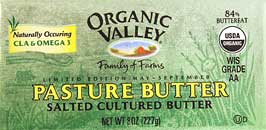
Organic Valley’s Pasture Butter is salted and cultured and is only available from May to September to ensure quality. The milk is produced without the use of antibiotics or hormones. They also have a European Style Cultured Butter that is delicious, though I find that it is not quite so sweet, plus, it is unsalted. The European Style is known to make very good pastry crusts, but I have yet to experiment with it. I find mine at Vitamin Cottage here in Denver, but I know that Whole Foods and certain other grocery stores carry it as well. I stopped buying OV’s butter though because I don’t agree with their business practices.
Smjör Imported Icelandic Butter is a new discovery for me. It has the same golden yellow color as the Organic Valley butter, but there is less salt and the flavor is a little more subdued. According to the post by Rob Endelman, the Icelandic Consulate in NYC reported that hormones and antibiotics are banned from use in cattle in Iceland. This alone makes it a much safer product that typical butter. Even though it is not officially organic, the pollution levels in Iceland are very low, so the grass that the cows graze on is much healthier.
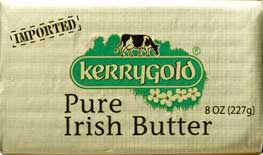
Kerrygold Butter is more widely available than the above two butters and it’s just as delicious. As with the other kinds, it is a rich yellow color and is full of high levels of CLA, Vitamin A, and Omega 3s. They only use grass-fed cows milk and only the milk from the summer months is used to make this butter. They have two kinds, a salted, sweet cream butter and an unsalted, cultured version.
Coconut Oil:
Coconut oil is something I can never be without. I use it for literally everything, from cooking to baking to body scrubs to skin moisturizer! It is one of the healthiest oils you could use and it has amazing health benefits, as long as you use the virgin, unrefined coconut oil. Using the unrefined version will allow you access to all the nutrients that coconut oil offers. Like any product, the more processing it undergoes, the more nutritional value is depleted.
Coconut oil is probably one of the most versitle ingredients you will have in your kitchen. You can not only use it as a food source, but as a skin care source as well. My favorite kind of coconut oil is the Gold Label Virgin Coconut Oil from Tropical Traditions. I have been using their oil for years and find that of the brands I’ve tried, it is the best quality oil out there. I have several friends who like the extra virgin coconut oil from Dr. Mercola, but I haven’t tried his brand, so I cannot accuratly compare it to the oil from Tropical Traditions.
Olive Oil
By now, I think most people know that olive oil is one of the healthier fats. It has been shown to offer protection against heart diseas because of its concentrated amount of monounsaturated acides and other antioxidents. It helps raise the LDL cholesterol levels. It is also very easy to digest and has been shown to help ulcers and other stomach problems. And if that’s not good enough, it has also been shown to help with colon cancer prevention.
There are several types of olive oil – I tend to only use extra virgin olive oil because, like the coconut oil, I try to consume food that is as close to its original form as possible. The more it’s processed, the more nutritional value you lose. Some people don’t like the flavor of extra virgin olive oil, but it is the version that you will get the most health benefits from. I don’t have a favorite brand of olive oil. I used to just get the organic extra virgin olive oil from Costco, which is imported from Italy. However, there have been recent reports about most olive oils being cut with vegetable oil, so I have started getting pretty picky on where I buy olive oil. Chaffin Family Orchards is the most wonderful oil I’ve tasted, however, it is rather expensive, so it’s not always in the budget. It is super mild and is perfect for homemade mayonnaise.
SUGARS
Sugar is one of those substances that should be consumed in moderation. However, that doesn’t mean you should never enjoy something sweet and delicious. It just shouldn’t be a main part of a healthy diet. The average American consumes two to three pounds of sugar per week. Our overly processed food is full of sugar, even in items that are not sweet. In the last 20 years, sugar consumption in the US has increased from an average of 26 pounds to 135 pounds per person, per year. It’s no wonder that diabetes is now an epidemic in the US. Over consumption of sugar and proceeded carbs (which turn to sugar in your body) can cause many health issues, including high blood pressure, heart disease, insulin resistance, immune system suppression and more.
Refined sugar, like high fructose corn syrup, white table sugar, and dextrose should be avoided at all costs. You’ll find these sugars in all sorts of unexpected food items, from bread to spaghetti sauce to peanut butter and tons more. The best thing you can do is to always read the label and avoid buying pre-packaged, processed foods whenever possible.
These are the sugars that I use in my kitchen. I never use white sugar or corn syrup in any of my cooking and baking. I strive to eat sugar in moderation (something that is very hard for me because of my massive sweet tooth), but when I do get the hankering for a sweet treat, I use these sugars.
Coconut sugar:
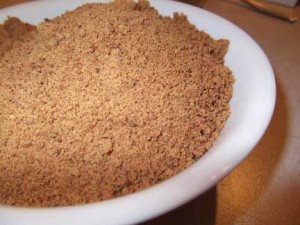 I discovered coconut sugar awhile back and I love it. It has a brown sugar taste, which I personally like in just about everything, but some people might not like it as much. It works wonderfully in baked goods and I even put it in my coffee.
I discovered coconut sugar awhile back and I love it. It has a brown sugar taste, which I personally like in just about everything, but some people might not like it as much. It works wonderfully in baked goods and I even put it in my coffee.
Coconut sugar is a low-glycemic sugar, which is one of the things I love about it. It is a 35 on the GI (Glycemic Index) scale, where commercial honey is a 55 and cane sugar is a 68. It has long been used in Asian cooking. In addition to it being low in the GI scale, it also is rather nutrient dense. It is full of potassium, magnesium, zinc, iron, and vitamin C, as well as the B1, B2, B3, and B6 vitamins.
You should always look for organic coconut sugar that is unprocessed, unfiltered and unbleached and has no preservatives. I get mine at Vitamin Cottage and it is about $4.82 per pound.
Raw Honey:
There is debate on whether raw honey is low on the GI scale – I have read information that have it both ways. According to the Wikipedia entry on honey, it says that the GI of honey is between 31 and 78, depending on the variety. From what I have found, raw honey has a GI of 30. Either way, I still use it in my cooking. The thing that draws me to honey is that it has been used for thousands of years and it has amazing healing properties. It can be used not only for consumption, but is also has medicinal properties as well. I have used it on cuts and scrapes and even on cold sores and it has worked miracles.
Always get raw honey – it is the only way to ensure that you are getting a pure, unprocessed product. Raw honey is never heated, pasteurized or processed. When honey is heated, you lose the valuable yeasts and enzymes that give it its healthy properties. Local raw honey is best and is typically very easy to find at your local farmers markets. If you can’t find any locally, Tropical Traditions has a great organic, raw honey that is affordable too.
Maple syrup:
Maple syrup is not really on the low end on the glycemic scale, but it is a staple in my kitchen. It has a GI of 54. I like maple syrup, because of its rich flavor and the fact that it is a great source of manganese and zinc. Both of these nutrients are important to a healthy immune system and to heart function.
When selecting maple syrup, make sure you get REAL maple syrup. It’s always a good idea to take a look at the label and make sure it has nothing else in it than maple syrup. You also want to make sure your maple syrup is formeldahyde free. Formeldahyde is often used during processing. I always buy organic, Grade B maple syrup because in my opinion, it has the best taste, is the least refined, and has the most minerals.
Stevia:
Stevia is not really a sugar. It is actually a sweetener that is derived from the stevia plant’s leaves. It is super sweet at 200-300 times sweeter than table sugar, so a little goes a long way. The nice thing about stevia is that it has a GI rating of less than 1. Stevia has been used in Japan as a sweetener for many years. But, in other countries it is banned. It is best to use this sweetener in moderation since it is a relatively new sweetener and traditional cultures have actually chewed on the leaves for the sweet flavor, rather than have it comepltey concentrated like you can now get it.
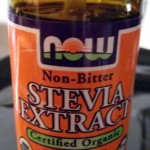
NOW brand has a non-bitter stevia that I like. Sometimes stevia can have a bitter, “green” taste. Some people have commented that it tastes like licorice. I have found, with much experimentation, that stevia works best when used with something that has another form of sugar in it. I tend to use it in things like smoothies or baked goods that already have natural sugars in them. Stevia will then hide behind those other sugars and will not taste bitter or licorice-y.
FLOURS
Almond meal:
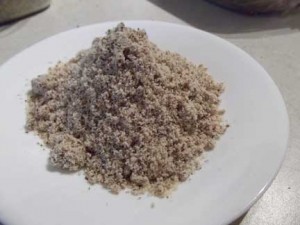 Almond meal is one of my favorite “flours” to use. It is gluten free, so it has been a welcome addition to my kitchen. It’s not technically a flour, it is simply raw almonds (with the skins) that are ground up into a meal. You can also get almond flour, which is blanched almonds (no skin) and is whiter and lighter than the meal. The texture of almond meal is more course than that of regular flour. It is more like the texture of corn meal.
Almond meal is one of my favorite “flours” to use. It is gluten free, so it has been a welcome addition to my kitchen. It’s not technically a flour, it is simply raw almonds (with the skins) that are ground up into a meal. You can also get almond flour, which is blanched almonds (no skin) and is whiter and lighter than the meal. The texture of almond meal is more course than that of regular flour. It is more like the texture of corn meal.
Almonds are little powerhouses of nutrition. They are packed full of fiber and protein, plus vitamin E, good fats, magnesium, zinc, calcium, phosphorus and folic acid. It is important to keep your almond meal refrigerated. Nuts can go rancid very quickly, so keeping it in the fridge will help preseve its flavor and nutritional value.
I find that almond meal works best in recipes like nut breads, muffins, some cakes and cookies. It cannot be used interchangibly with wheat flour, so it’s best to only use it for certain recipes. It is a great alternative for lower carb baked goods, but since it is made of almonds, it can be calorie dense. I get my almond meal in the bulk, refrigerated section of Vitamin Cottage, but it is available at other health food stores and online.
Coconut flour:
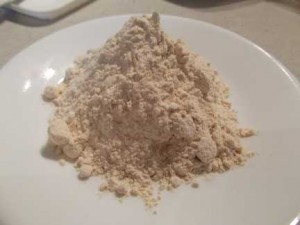 Coconut flour is another great gluten free flour. Because it comes from coconut meat, once the oil has been removed, it is extremely high in fiber and protein. As a matter of fact, a 3.5 ounce serving has over 38 grams of fiber and 19 grams of protein in it! Because of the extra fiber, items made with coconut flour will keep you fuller longer, aiding in weight loss. The extra fiber also helps with digestion, heart health and immune system function.
Coconut flour is another great gluten free flour. Because it comes from coconut meat, once the oil has been removed, it is extremely high in fiber and protein. As a matter of fact, a 3.5 ounce serving has over 38 grams of fiber and 19 grams of protein in it! Because of the extra fiber, items made with coconut flour will keep you fuller longer, aiding in weight loss. The extra fiber also helps with digestion, heart health and immune system function.
Coconut flour is much lighter in texture than the almond meal, so it is a better option for lighter cakes, cookies and breads. Like the almond meal, it cannot be used interchangeably with regular wheat flour, but many recipes can be adapted to use this ingredient instead of wheat. I either purchase mine from Vitamin Cottage, or online from Tropical Traditions.
